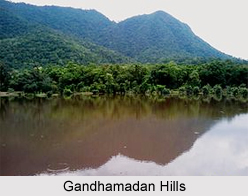 Tourism in Bargarh covers the pilgrimage tourism destinations and the nature tourism destination and clearly vivifies the existence of this region with civilisation of the Vedic era. There the existence of Gupta era is found in the colours of festivals. Some of the well acclaimed destinations in Bargarh are Nrusinghnath, Gandhamardan, Baijal Dev and the local small hills which are apt for any easy trekking.
Tourism in Bargarh covers the pilgrimage tourism destinations and the nature tourism destination and clearly vivifies the existence of this region with civilisation of the Vedic era. There the existence of Gupta era is found in the colours of festivals. Some of the well acclaimed destinations in Bargarh are Nrusinghnath, Gandhamardan, Baijal Dev and the local small hills which are apt for any easy trekking.
Nrusinghnath
Nrusinghnath is situated at a distance of 110 km from Bargarh. Being a lone pilgrim spot, it has been appealing the minds of lakhs of people, with magical glitters, for the last so many centuries. This is the Dawning - place of the mentioned Lord Nrushinghnath, the presiding Deity of the sacred mount Gandhamardan - endearing multitude of memories, surprisingly amalgamating the legends of the Ramayana, the Mahabharata, the Buddhist Era; even reminiscent of Bhoj Raj era, Kabir era and Tantracharya Nagarjuna (the preserver of all scripture). Nrusinghnath is a form of Hindu Lord Vishnu.
Gandhamardan
In the Tretaya Yuga, Jambavan (the unerring counsellor of Ram) had suggested Vir Hanuman to bring Bisalyakarani ere dawn, so that Laxman would rise back to life. It was in the middle of the war between Lord Ram and Ravan. Hanuman failed to identify the particular herb and carried on his shoulders a huge Himalayan mass. While flying above and proceeding toward Lanka (the kingdom of Ravan), a portion dropped down. Gandhamardan is synonymous to that portion only.
Parimalgiri
When Hieun Tsang visited India, he was attracted by the scenic splendour of Gandhamardan, during his tour to Dakhin Koshal (part of which is current Chattisgarh and the bewitching colourful zone of Western Odisha). He has spoken of the flowering Buddhist University of Parimalgiri which had its campus on the picturesque Gandhamardan hills.
Natural Herbs in Gandhamardhan
Gandhamardan is the house of all medicinal herbs in India. It is the home of more than 5000 rare medicinal herbs providing medicines for fatal diseases like cancer, tuberculosis, leprosy, filarial, epilepsy, asthma, kidney and lever dysfunctions even AIDS. Gandhamardan serves as a wildlife sanctuary for large number of rare species of birds and animals and there by donating its portions towards balancing the global ecological pyramid.
Baijal Dev Temple
The foundation for the temple was laid down by Baijal Dev on March 17, 1413 A.D. as per inscriptions. It is divided into two parts; the first being the seat of the Lord - a short raised narrow plinth and the other Jaga Mohan (the antechamber) having three gates and is supported by four pillars, the like found nowhere in Odisha. The rocks used in the Jaga Mohan pillars are of rare kind. They are not seen in the Gandhamardan hills. It is believed that, from far off places, Baijal Dev had brought them. With a soft rubbing, these rocks begin to scintillate, to a degree. While entering inside the inner-sanctum, one can see the rock statues of Nav Grahas (the Nine planets of Astrology) in a line. The other beautiful sculptures include the statutes of Ganga, Jamuna, Nandi, Jaya-Vijaya, Trividram and three conspicuous manifestations i.e. Bamana, Baraha and Samhar Nrusimha. The eight-handed Ganesh and the Cow-herd Sahadev are not inserted rather they are carved on embedded prototype, near Nav Durga. The original idol of Nrusinganath is also kept.
Papaharini River
The main perennial river flow of Gandhamardan is Papaharini River which is literally means "The Destroyer of Sins". It is symbolic of Sanatan-the continuum of past, present and future. Flowing out of the confluence of seven fountains, called Saptadhar - it has an average width of 12 ft. No man made tributary can flow into it. Nothing can pollute or adulterate it. Running about 25 km it has touched the Ang Tributary and finally embraced Mahanadi River.
Asta-Sambhu Temple or Eight Temples
In Bargarh, a large number of Siva Temples were built during the Chauhan rule of undivided Sambalpur. The most important among them were those of the Asta-Sambhu or 8 Siva Temples such as (1) Bimaleswar Temple at Huma (Sambalpur), (2) Kedarnath Temple at Ambabhona (Bargarh), (3) Baidyanath Temple at Deogaon (Bargarh), (4) Balunkeswar Temple at Gaisama (Bargarh), (5) Mandhata Baba Temple at Maneswar (Sambalpur), (6) Swapneswar Temple at Sorna (Bargarh), (7) Visweswar Temple at Soranda (Bargarh) and (8) Nilakantheswar Temple at Nilji (Bhatli).
Bimaleswar Temple
Bimaleswar Temple at Huma on the Mahanadi River was built by Maharaja Baliar Singh and the rest were built during the reign of Ajit Singh and his son Abhaya Singh. These temple, though small height, are great artistic beauty and each of these with picturesque background.
Dadhibaman Mandir
Dadhibamana Mandir is situated at Bhatli- one of the Block of Bargarh District. Dadhivaman is a form of Lord Jagannath and a parallel cart festival is organized accordingly. Bhatli is known as the Shreekhetra of Western Odisha.
Related Articles
Cities of Orissa
Bargarh
Odisha
Puri
Temples of Odisha



















